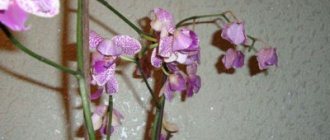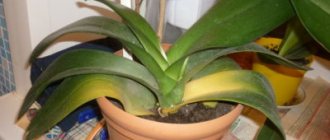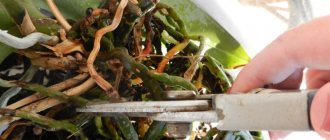Features of flowering
The orchid begins to bloom at the age of 1.5-2 years, when 5-8 leaves have formed on the stem.
Flowering too early is undesirable: it will be difficult for the plant to regain its strength and it may die.
An orchid can bloom profusely for up to 7 years. After this, flowering is reduced to 1-2 months, and it cannot be extended despite careful care. In this case, plant rejuvenation is required.
There are several phases in the development of an orchid:
- The growing season begins with the formation of a new shoot - leaves and root systems grow.
- During the dormant period, new buds and peduncles are formed.
- During the flowering phase, the plant expends energy.
- This is followed by a period of rest, recuperation and accumulation of energy for new flowering.
Typically the flowering phase lasts about three months and begins in the fall. With proper maintenance, a strong plant can produce flowering shoots even in the spring, having time to replenish its strength. Peduncles can appear three times a year. With quality care, orchids can bloom for more than 8 months.
Is it possible to save the arrow if it falls off?
Attempts to preserve the buds that have lost their buds and are beginning to dry out are pointless. Yellowing in the lower part of the peduncle indicates that biological processes in the tissues have stopped and there will be no recovery. Dry flower stalks are a source of reproduction of diseases and pests, so they are cut off and the wound is treated with charcoal.
If you handle the orchid carelessly, you can accidentally break off the flower arrow. If part of the shoot is damaged, the remaining part will continue to flower. The plant is already programmed to form buds, and there is no need to stimulate flowering.
After completely breaking out the shoot from the base, the orchid can produce a new shoot with buds. In this case, flowering will simply be delayed for several months. Following the rules of care will help set the plant up for new bud formation. It is advisable to increase the duration of daylight hours at this time.
Additional stimulating measures will help speed up the onset of flowering:
- ensuring a difference of day and night temperatures of 5 degrees;
- spraying the plant with a solution of succinic acid;
- treating the waiting bud with cytokinin paste after first freeing it from the top layer.
If the peduncle is completely broken and there is no waiting bud below, the arrow is removed without waiting for it to dry out naturally. The cut is covered with garden varnish to prevent infection from entering the trunk.
For your information! A broken arrow is not able to grow together, so tying it, as inexperienced gardeners do, is useless. It is better to cut off the stem at the break point, and place the part with the buds in a vase with water.
What can speed up the process of buds withering?
A reduction in flowering time and rapid natural wilting of buds may depend on the age of the orchid. Older plants will have buds that quickly wither. In plants of active age, accelerated wilting of buds can occur when:
- Moving a flower pot from its usual place.
- Insufficient lighting.
- Sudden temperature fluctuations.
- Close location to heating radiators in winter.
- Violation of the watering schedule.
- Excessive or low air humidity.
- Pollination of flowers by insects flying in from the street.
- Exposure to ethylene emanating from ripe bananas, apples lying next to an orchid.
Floral stress
It often happens: you buy a magnificent blooming beauty in a store, and when you bring it home, it sits for a day or two and withers. There may be several reasons why the orchid's buds dry out in this case. One of them may be that the flower’s usual environment has changed. Don't be surprised, plants are also susceptible to stress. If this is the case, the orchid will definitely bloom again. It is much worse if you purchased a diseased plant. A healthy orchid has no spots on the leaves, the aerial roots are silver in color, slightly green after watering, and the underground root system is rot-free and well developed. Some may ask why the seller’s plant bloomed, but didn’t want to go home? Because in the store he had a familiar environment, and perhaps he was fed various stimulants there. At home it lost all this, so it dropped its buds.
When is shedding natural and when is it not?
The flowering of an orchid begins with the smooth and slow opening of a bud located closer to the end of the peduncle. First, the side and upper petals unfold, and then the lip and the entire flower open. This happens within 24 hours.
The flower lasts 2-3 days. Then it withers, dies and falls off. This is a natural process. The flower that opens first falls first. With a sudden drop, the flowers wither and fall chaotically, regardless of the beginning of the opening of the buds.
Important! To track the development of flowers, when purchasing, it is better to choose plants with barely opened buds.
Expert advice on handling faded orchid fronds
What to do with the faded arrow of an orchid must be decided according to the circumstances. Mandatory complete pruning is recommended only when an infectious disease is detected. However, some experts are inclined to believe that in other cases it makes no sense to save it:
“An old peduncle can sometimes produce lateral flowering or resume growth along the main axis. But usually such flowering is not lush. In my orchidarium, I immediately cut out the bare arrows so that the orchids can direct their energy to growing new ones.”
E. Borodulina, orchid grower with 10 years of experience
Why does this happen: main reasons
When an orchid quickly sheds buds and flowers, you should wonder why this is happening. It is necessary to analyze the system of caring for the plant in order to help it and protect it from death. Common reasons:
Temperature violation
Orchids are sensitive to temperature changes and drop flowers when:
- Hypothermia. Inflorescences die at temperatures below +5°C. A cold window sill in winter can cause the buds to drop.
- Overheating from direct sunlight or radiators in winter. This injures the roots and dries out the soil.
- Sudden changes in temperature. A decrease of more than 4°C is a signal of the end of the flowering period.
- Drafts and excessive ventilation.
Insufficient lighting
Orchids produce buds as daylight increases. The development of buds requires more and more light. If there is not enough sunlight, the buds will fall off.
The orchid grows best on light eastern windowsills.
On southern windowsills, flowers are shaded from the direct rays of the sun. Orchids also grow on northern windows, but they require additional lighting. In cloudy winter weather, orchids are illuminated with fluorescent lamps for up to 10-12 hours of daylight.
Low air humidity
The most comfortable air humidity for a blooming orchid is at least 60%. When the humidity drops to 50%, not only the buds begin to drop, but also a general deterioration in the condition of the plant.
Humidity is increased in one of the following ways:
- Place open bowls of water next to the plant.
- In the morning, spray the leaves and roots with water.
- Set up a small fountain or automated humidifier.
- Place the pot with the orchid on a tray with damp expanded clay.
When placing the pot on a tray with expanded clay, the bottom should not touch the water to prevent rotting of the roots from waterlogging.
Improper watering
Overdrying and waterlogging the soil is detrimental to the orchid. The soil in the pot should be slightly moist, but not wet.
Presence of diseases and pests
The orchid may appear:
- Gray rot - gray spots form on the lower part of the plant. The disease can be caused by waterlogging of the soil, hypothermia or an overdose of nitrogen fertilizers.
- Root rot - manifested by browning of leaves, softening of roots, which no longer provide the plant with moisture and nutrition. They are treated with the drugs “Fundazol” and “Topsin”. Treat 2-3 times every 20 days.
- Mealybug - the foliage turns yellow, a white fluffy coating forms in the axils. The scale insects are removed with a soap solution, and then the plant is sprayed with an insecticide.
Common varieties of indoor orchids
Most often, hybrid varieties are grown indoors: they are more adapted to life in an apartment, and it is easier for them to provide a suitable environment for long life and flowering. Some varieties can bloom all year round: flower stalks replace each other, and with proper care, the plant constantly pleases the owner with beautiful buds.
We can list several of the most common representatives of the Orchid family:
- Phalaenopsis is a familiar orchid with elongated dark green leaves and curved peduncles. Phalaenopsis, with sufficient sunlight and a comfortable temperature in the room, can bloom all year round; this is one of the most convenient hybrids to grow.
- Oncidium is a light-loving variety with large buds, the shape of which resembles butterflies. Hybrid varieties of orchids are usually grown indoors because they require less sunlight.
- Miltonias are an amazingly beautiful type of orchid that is often grown in greenhouses. Miltonias have a curved stem and large flowers, the diameter of which reaches 8 cm. Externally, the buds resemble pansies due to their unusual coloring. This is a rather capricious flower; it is often grown by orchid breeders.
- Cymbidium. In nature, these are large orchids with large buds and narrow bright leaves. Miniature hybrid varieties are often grown in rooms. Their advantages are unpretentiousness and long flowering; each flower can live up to 12 weeks.
These are just some of the varieties that can be found both in greenhouses and winter gardens, and in ordinary apartments. Beginning flower growers need to understand the optimal watering and lighting conditions. To provide the orchid with good conditions for flowering.
Step-by-step instructions: what to do to save the plant?
To save the plant, you need to know what to do next with the orchid if all the flowers and buds have fallen off.
With blossoming flowers
- Isolate the plant from other potted crops.
- Carefully examine the leaves, axils, and root areas. If signs of disease or pests are detected, treat.
- Provide comfortable temperature conditions: 20-24°C during the day and 15-18°C at night.
- Increase air humidity if it is insufficient.
- Maintain soil moisture, avoiding overdrying or waterlogging.
- Avoid drafts.
With unopened buds
- Isolate the plant.
- Conduct a thorough inspection of all parts of the plant. If pests or signs of disease are detected, treat the orchid.
- If the pot has been moved, return it to its original place in the same position.
- If there is a lack of light, equip additional lighting with a fluorescent lamp.
- Analyze the watering schedule and adjust in cases of dehydration or overflow of the substrate.
- Provide plant nutrition, paying attention to phosphorus-potassium ingredients.
- Check the temperature.
- If the air is extremely dry, provide humidification.
Insufficient watering
If the irrigation regime is violated, the plant may also begin to yellow the leaves. After all, an orchid is a tropical plant and therefore is sensitive to moisture loss.
How can you tell if a plant is too dry?
During a long dry period, the leaves of the flower wrinkle from loss of moisture, and at the same time yellowness occurs on the lower leaf plates.
Drying out of an orchid can also be determined by its roots.
Added to this is the loss of turgor in the leaves throughout the entire bush. Indeed, to develop roots, which is what an orchid primarily does, it takes strength from the leaf mass. If a flower is often in an overdried state, it begins to dry the lower plates of the leaves, taking nutrients from them. Often the leaves of the orchid fall off.
IMPORTANT! When kept dry, the bark is always dry and dries quite deep into the container. This is clearly visible, since orchids are usually grown in transparent containers.
How should a plant be watered when it gets dry?
After drying out, the flower needs to replenish its moisture. Therefore, you can use the bottom watering method. For this:
- We put the container with the flower in the water and leave it there, not as usual, for 20 minutes, but let it sit in the water for at least a day;
- After being removed from the water, the pot will be quite heavy due to the fact that the bark will have absorbed a lot of moisture;
- The leaves will become elastic again in 5-6 days. This time is necessary for moisture from the roots to reach each cell of the leaf;
- We do the next watering as usual and when there is no longer condensation on the inner wall of the pot.
IMPORTANT! This method can be used if the root system of the plant is not damaged. Such bathing cannot be arranged systematically.
What does overwatering lead to?
A constant excess of water leads to:
- To rotting of the root mass;
- And infection with various fungal infections of orchid leaves.
To prevent this from happening, you must correctly observe the frequency of watering and do not overwater the plant.
The use of folk and chemical remedies for prevention
To extend the flowering period, gardeners use home remedies.
Attention! All folk fertilizers are used in solutions of low concentration. Their shelf life is less than a week.
Banana peel infusion
Banana peel contains substances useful for the formation of flower stalks.
Fertilizer preparation:
- The dried peel of one banana is crushed.
- Pour the mixture with one liter of warm water and leave for 2-3 days.
- The mixture is filtered and diluted with settled warm water in a ratio of 1:2.
- The orchid is carefully watered with the resulting infusion.
Onion peel decoction
Onion fertilizer stimulates the formation and growth of flower ovaries.
Onion fertilizer is prepared:
- The peel of one onion is poured with a glass of water.
- Boil for 10 minutes over low heat.
- Leave for 1-2 hours, filter.
- The flowers are watered with a decoction diluted with water to a light shade at room temperature.
Potato fertilizer
Potato infusion stimulates the formation of buds and the growth of the root system. Peelings from several small potatoes are poured with boiling water, left for half an hour, and filtered. The resulting mixture is watered at a temperature of 35°C.
To feed orchids and extend flowering time, flower growers recommend using the following preparations:
- "Greenworld" - for root feeding and spraying.
- "Bona Forte" is a complex fertilizer that stimulates re-blooming.
- “Kemira-lux” is the most popular among flower growers.
The fertilizing of orchids provides the necessary nutrients not only to the flower stalks, but also to the entire plant, giving it vitality and strengthening the immune system. A strong, healthy plant does not shed flowers and buds.
Strict adherence to all rules for caring for an orchid helps prevent the dropping of buds and flowers. A healthy plant in comfortable conditions will bloom long and profusely, delighting everyone with its unusual outfit.
Humidity: optimal value
Lack of moisture or its excess is the most common cause of problems. An acute lack of moisture occurs if watering is stopped for some reason. In this case, resuscitation cannot be avoided!
Instructions for this case:
Pour water at room temperature into a basin to a level of no more than 15-20 cm. Immerse in a basin of water and wait until the earthen lump becomes limp. Please note that the leaves must be dry when immersed in the basin! If the earthen ball is too limp, it is necessary to place the patient in a new pot.
Keeping it too wet creates another serious problem: the phalaenopsis begins to rot. Affected by rot, the flower loses its foliage, the leaves become soft, and the flowers fall off.
Rotting is always easier to prevent than to treat. If 90% of the plant is infected, it will die!
It is important to take timely measures and eliminate the causes of rot:
- Remove the flower from the pot.
- Rinse the roots under warm running water.
- Remove damaged roots and leaves.
- Remove wilted flowers.
- Treat the sections with an antiseptic.
- Leave to dry overnight.
- Replant the orchid in new soil with a drainage layer.
- Water only after the soil has dried.
Antiseptics for orchids: Fundazol, Fitosporin. Treatment of wounds against rot: Chlorhexidine. After reading such detailed instructions, the question remains: how to properly water an orchid?











